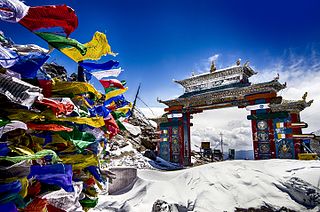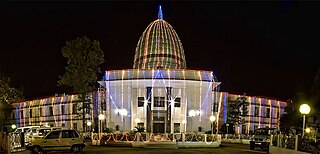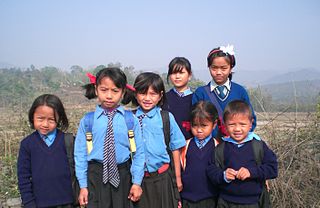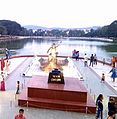
Tourism in India is 4.6% of the country's gross domestic product (GDP). Unlike other sectors, tourism is not a priority sector for the Government of India. Forbes magazine ranked India as the 7th most beautiful country in 'The 50 Most Beautiful Countries In The World' rankings. The World Travel and Tourism Council calculated that tourism generated ₹13.2 lakh crore (US$170 billion) or 5.8% of India's GDP and supported 32.1 million jobs in 2021. Even though, these numbers were lower than the pre-pandemic figures; the country's economy witnessed a significant growth in 2021 after the massive downturn during 2020. The sector is predicted to grow at an annual rate of 7.8% to ₹33.8 lakh crore (US$420 billion) by 2031. India has established itself as the 5th largest global travel healthcare destination with an estimated market size of around $9 billion in 2019, out of the total global travel healthcare industry of $44.8 billion(2019). In 2014, 184,298 foreign patients travelled to India to seek medical treatment.

Northeast India, officially the North Eastern Region (NER), is the easternmost region of India representing both a geographic and political administrative division of the country. It comprises eight states—Arunachal Pradesh, Assam, Manipur, Meghalaya, Mizoram, Nagaland and Tripura, and the "brother" state of Sikkim.
Hmar is a Kuki ethnic group living in Northeast Indian state of Manipur, Mizoram, Assam and western Myanmar (Burma) and eastern Bangladesh. They use Meitei language as their second language (L2) in Manipur. They speak Mizo language as their L1 in Mizoram.

Shillong is a hill station and the capital of Meghalaya, a state in northeastern India. It is the headquarters of the East Khasi Hills district. Shillong is the 330th most populous city in India with a population of 143,229 according to the 2011 census. It is said that the rolling hills around the town reminded the British of Scotland. Hence, they would also refer to it as the "Scotland of the East".

The Gauhati High Court was promulgated by governor general of India on 1 March 1948 after the Government of India Act 1935 was passed, establishing the high court with effect from 5 April 1948, for the then-province of Assam. It was originally known as the High Court of Assam and Nagaland, but renamed as Gauhati High Court in 1971 by the North-Eastern Areas (Reorganisation) Act, 1971.

Central Agricultural University is an agricultural university at Lamphelpat, Imphal in the Indian state of Manipur.
The Ministry of Development of North Eastern Region is a Government of India ministry, established in September 2001, which functions as the nodal Department of the Central Government to deal with matters related to the socio-economic development of the eight States of Northeast India: Arunachal Pradesh, Assam, Manipur, Meghalaya, Mizoram, Nagaland, Tripura and Sikkim. It acts as a facilitator between the Central Ministries/ Departments and the State Governments of the North Eastern Region in the economic development including removal of infrastructural bottlenecks, provision of basic minimum services, creating an environment for private investment and to remove impediments to lasting peace and security in the North Eastern Region.

Assam is the main and oldest state in the North-East Region of India and as the gateway to the rest of the Seven Sister States. The land of red river and blue hills, Assam comprises three main geographical areas: the Brahmaputra Valley which stretching along the length of the Brahmaputra river, the Barak Valley extending like a tail, and the intervening Karbi Plateau and North Cachar Hills. Assam shares its border with Meghalaya, Arunachal Pradesh, Nagaland, Manipur, Tripura, Mizoram and West Bengal; and there are National Highways leading to their capital cities. It also shares international borders with Bhutan and Bangladesh and is very close to Myanmar. In ancient times Assam was known as Pragjyotisha or Pragjyotishpura, and Kamarupa.

The following outline is provided as an overview of, and topical guide to, India:
North East India Christian Council (NEICC) is a Protestant ecumenical council of North East India, affiliated to the National Council of Churches in India as one of the regional councils in the year 1939.
Ralengnao Khathing MC, MBE (1912–1990), also known as Bob Khathing, was an Indian soldier, civil servant and diplomat and the first person of tribal origin to serve as an Ambassador for India. The Government of India honoured him in 1957 with the award of Padma Shri, the fourth highest Indian civilian award for his services to the nation. Khathing led the first armed forces into Tawang that established Indian control in the region under the direct supervision of the then Assam governor Jairamdas Daulatram.
The North-East Democratic Alliance is a political coalition that was formed on May 24, 2016, by Bharatiya Janata Party. The motive of the new political front was to protect the interest of the people of the region as well as uniting non-Congress parties in Northeast India. Himanta Biswa Sarma was appointed as the convenor of the front.

Northeast India International Travel Mart is a tourism event to showcase the Northeastern region of India, which is popularly known as the North East. This event is organised by the Ministry of Tourism of the Government of India in association with hosting State Governments and other states in the region. The regional states are Arunachal Pradesh, Assam, Manipur, Meghalaya, Mizoram, Nagaland, Sikkim, Tripura and West Bengal. One of the nine states hosts the event annually.
The Republic of India shares borders with several sovereign countries; it shares land borders with China, Bhutan, Nepal, Pakistan, Bangladesh and Myanmar. Bangladesh Myanmar and Pakistan share both land borders as well as maritime borders, while Sri Lanka shares only a maritime border through Ram Setu. India's Andaman and Nicobar Islands share a maritime border with Thailand, Myanmar, and Indonesia.
The College of Horticulture Thenzawl is one of the constituent colleges of the Central Agricultural University. It is in Thenzawl in the state of Mizoram.
The 2019 Santosh Trophy qualifiers was the qualifying round for the 73rd edition of the Santosh Trophy, the premier competition in India for teams representing their regional and state football associations.

The hill tribes of Northeast India are hill people, mostly classified as Scheduled Tribes (STs), who live in the Northeast India region. This region has the largest proportion of scheduled tribes in the country.
Bar Council of Assam, Nagaland, Meghalaya, Manipur, Tripura, Mizoram, Arunachal Pradesh and Sikkim is the regulatory and statutorily representative body for lawyers practicing law in the states of Assam, Nagaland, Meghalaya, Manipur, Tripura, Mizoram, Arunachal Pradesh and Sikkim. It was constituted as per the mandatory requirement as per Advocates Act, 1961 and Bar Council of India. In March 1953, S. R. Das as head of the 'All India Bar Committee', proposed the creation of the apex body as an All-India Bar Council and Bar council at state levels and submitted a report to the Central Government of India. Members of the Bar Council are elected from among members enrolled and practicing as lawyers practicing law in the states of Assam, Nagaland, Meghalaya, Manipur, Tripura, Mizoram, Arunachal Pradesh and Sikkim and they represent the state in Bar Council of India meetings. Bar Council of a place designs standards of professional conduct to be followed by members, and designs etiquettes and has the power to enforce disciplinary guidelines over the members of bar council.
North Eastern Railway Connectivity Project is an multi phased railway connectivity project in Northeast India which comprises states of Arunachal Pradesh, Assam, Manipur, Meghalaya, Mizoram, Nagaland and Tripura and it also includes the state of Sikkim. These states come under Northeast Frontier Railway Zone of Indian Railways. This Railway project is considered as strategically important for India because it connects all the border states in this region and also close to ASEAN countries.














































































